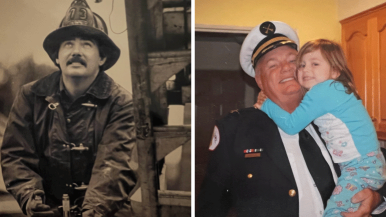For 35 years, Thomas Magliano bounced all over the city as a Chicago firefighter and citywide chief — and he’s got the stories to prove it.
“We had a fire once, and we walk in and the guy had balloons hanging, filled with gasoline,” he said. “You never knew what you were walking into.”
Magliano is now retired, living the grandparent’s dream of being down the street from his grandkids. Last April, he heard that RUSH University Medical Center and the Chicago Fire Fighters Union were offering low-dose CT scans to screen for lung cancer and other diseases for Chicago firefighters and retired firefighters.
He decided, more or less on a whim, to get one. Though he had no worrying symptoms, he had noticed that he felt colds severely when he got them.
“I figure it doesn’t cost you anything, the union is picking it up,” he said. “I thought why not?”
He was one of hundreds of firefighters who have been screened as part of the initiative. He expected to hear the all-clear a few days later and move on.
Instead, he got a call from RUSH informing him that he had a tumor in his right lung. He needed to go in to discuss his options.
Hidden dangers of firefighting
Christopher Seder, MD, the thoracic surgeon at RUSH who diagnosed Magliano’s cancer, said that occupations like firefighting can put workers in ongoing direct contact with known carcinogens.
“We know that lung cancer is the leading cause of death worldwide among cancers, and smoking remains the greatest predisposing factor, with current and former smokers being at the greatest risk,” he said. “However, lung cancer is also strongly associated with environmental and occupational exposures. We know that firefighters have higher rates of not only lung cancers, but other cancers as well.”
Magliano said he often walked into burning asbestos, plastics and other materials that are now known carcinogens.
“In the ‘70s all these plastics were coming out, and you could smell them when they burned,” he said. “I remember during overhaul (the process of checking a building after the main fire is under control for hidden fires), you’d take your breathing apparatus off, you’d be throwing out mattresses, pieces of wall, all this stuff. And of course, you’d have a cigarette after you were done.”
Equipment could also be an issue. Magliano said fire stations did not have breathing apparatuses and tanks for every firefighter, and equipment materials were not the quality they are now.
“It’s nothing like it is today,” he said. “Now everybody has their own apparatus, and hoods and turnout gear.”
Did his colleagues know back then that they were putting their long-term health at risk? Magliano said it was part and parcel of the firefighter mindset — to push through the pain, to support your team and support the community.
“We didn’t think about it. They want to be these macho guys: ‘I can take it, I can take a beating, I’m fine,’” he said. “I’ve seen guys refuse to go to the hospital to get stitches, because the rules are if you have stitches, you can’t go back to work.”
Early detection
When Magliano saw Seder, he received some encouraging news. His cancer, a typical carcinoid tumor, was a stage 1 tumor, and it was curable.
“Only a minority of lung cancers are identified in the earliest stages,” Seder said. “If you can identify lung cancer early, the rate of cure goes up significantly. If you identify it at stage 4, once it has spread, it’s much, much harder to cure.”
Seder told Magliano that he could operate. No one wants to go through surgery, but Magliano and his wife Julie had just had an unimaginable tragedy: their son, Joey had died on May 2. The funeral was May 5. Magliano got the call May 9.
Julie was not interested in watching and waiting.
“My wife was going crazy,” he said. “’Go, go get it removed!’ So I went in and had it done.”
Seder conducted a video-assisted thoracoscopic surgery (VATS) right lower lobectomy, a minimally invasive procedure through small incisions to remove the tumor.
'Listen to the old man'
Magliano recently had a follow-up with Seder and is recovering well. Other than a dry cough and minor discomfort from the surgery, he said he’s back to his old self. He said he’s grateful to RUSH for providing the screenings that caught the cancer early enough, and for the care he received there.
“They took very good care of me,” he said. “The nurses are right there, they were great. I’ll tell you what, I’ve been to other hospitals, but I’ll go to Rush from now on.”
The partnership between RUSH and the Chicago Fire Fighters Union to provide free lung screenings was expanded to include hundreds of additional screenings for firefighters. In addition to Magliano’s cancer, the screenings found abnormalities in dozens of additional patients that led to referrals to appropriate specialists.
Low-dose CT scans help detect significant issues outside the lungs, including coronary artery calcifications (associated with heart disease, strokes and heart attacks), aortic aneurysms that could cause lethal internal bleeding, and abnormalities in the adrenal gland, kidney, liver, pancreas and bowel. When needed, patients have been referred for additional imaging to better evaluate a potential problem outside of the lungs.
Seder said that the work is a critical part of RUSH’s mission to provide essential care to men and women who have put their lives on the line for our community.
“They are the ones risking their lives running into burning buildings,” he said. “We’re thrilled to be able to perform this service for our local heroes.”
Magliano said he just hopes all the folks still in uniform pay attention to his story.
“I tell all the kids: All right, listen to old man. Go get tested. Early detection is key for these kids.”




